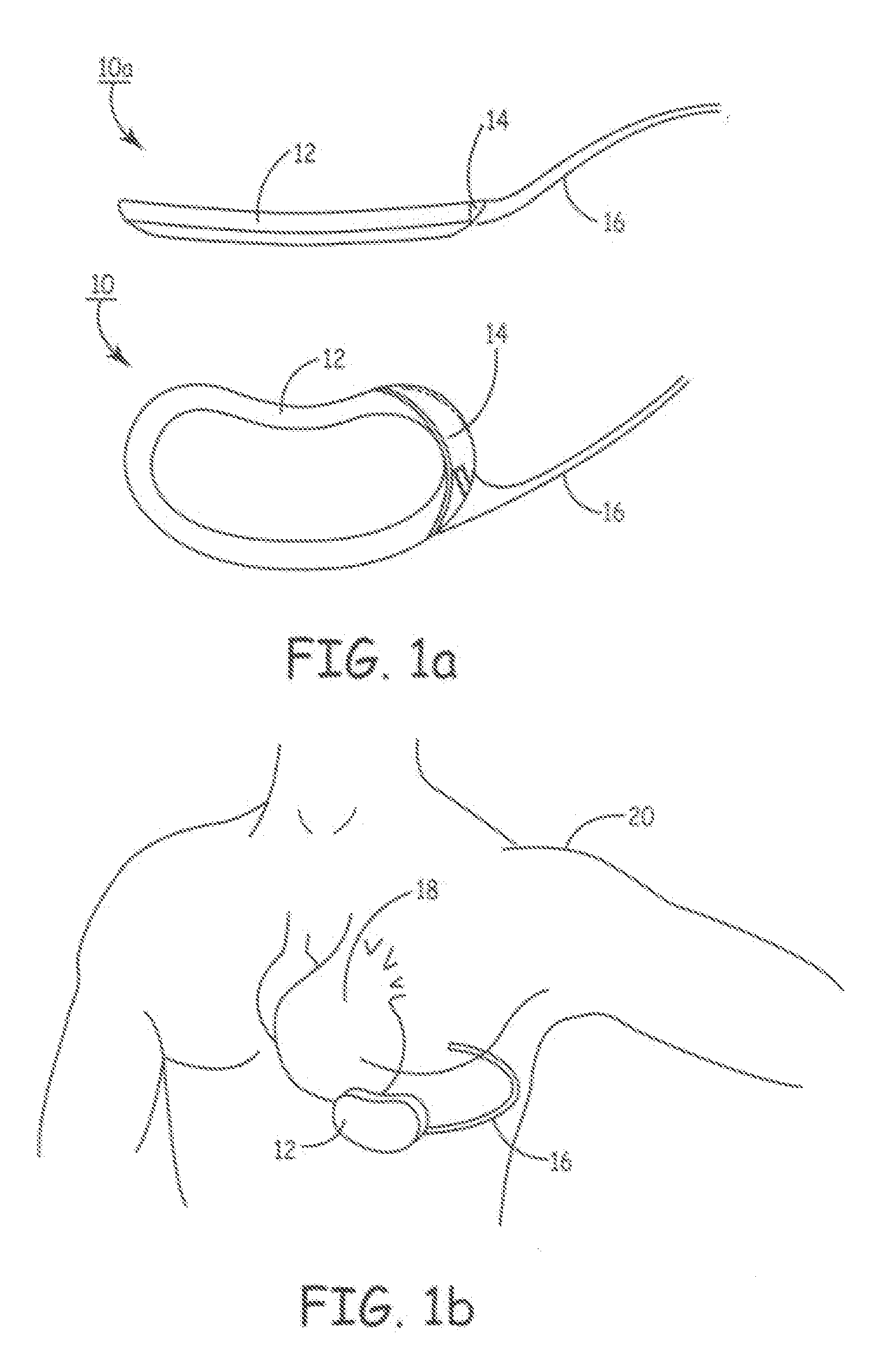Methods and Apparatus for Selectively Shunting Energy in an Implantable Extra-Cardiac Defibrillation Device
a technology of selective shunting and implantable extracardiac defibrillation, which is applied in the direction of internal electrodes, subcutaneous electrodes, therapy, etc., can solve the problems of more harm than good and render the eid inoperabl
- Summary
- Abstract
- Description
- Claims
- Application Information
AI Technical Summary
Benefits of technology
Problems solved by technology
Method used
Image
Examples
first embodiment
[0031]FIG. 1A depicts a multi-planar view of the present invention. EID 12 is an ovoid, substantially, kidney-shaped housing with connector 14 for attaching a subcutaneous sensing and cardioversion / defibrillation therapy delivery lead 16. EID 12 may be constructed of stainless steel, titanium or ceramic as described in U.S. Pat. No. 4,180,078 “Lead Connector for a Body Implantable Stimulator” to Anderson and U.S. Pat. No. 5,470,345 “Implantable Medical Device with Multi-layered Ceramic Enclosure” to Hassler, et al. The electronics circuitry of EID 10 (described herein pertaining to FIG. 21) may be incorporated on a polyamide flex circuit, printed circuit board (PCB) or ceramic substrate with integrated circuits packaged in leadless chip carriers and / or chip scale packaging (CSP). In one of the views, the concave construction of EID 12 is illustrated. The minor concavity of the housing of EID 12 follows the natural curve of the patient's median ribcage at about the cardiac notch. The...
second embodiment
[0034]FIG. 2A is a multi-planar view of EID 30, the present invention. EID 30 is a convex, flexible ovaloid-shaped housing with connectors 14 (two shown) for attaching a pair of subcutaneous sensing and cardioversion / defibrillation therapy delivery leads 16A and 16b. According to the invention one or more components capable of limiting electrical voltage, such as a metal oxide varistor 15 couples to the leads 16a and 16b and via a conductor 17 to a source of common electrical reference voltage (e.g., the housing of EID 30).
[0035]EID 30 may be constructed of stainless steel, titanium or ceramic. View 10A is a side view of EID 30 showing the tapered housing 30, a mid-line flexible joint 32, connector 14, lead 16 and active can electrode 38. The active can electrode 38 allows sensing and cardioversion, defibrillation and / or pacing therapy delivery between the EID 30 and one or both leads 16A or 16b. The jointed housing 30 allows physician flexibility in selecting implant locations and ...
third embodiment
[0037]FIG. 3A is a multi-planar view of EID 40. EID 40 is an elongated slender ellipsoid with sections of partially articulating dynamic segments having surface mounted subcutaneous sensing and cardioversion / defibrillation therapy delivery electrodes 44 and 46. EID 40 may be constructed of stainless steel, titanium or ceramic or equivalent. View 10A is a top view of EID 40 showing the segmented construction (at 42). One or more of the segmented portions 45 can be adapted to house, for instance, high voltage defibrillation circuitry 47. According to the invention, an energy limiting component (or components) 43 can couple to an electrical reference (e.g., a ground or common electrical potential for the device, such as a portion of the metallic housing) and to a conductor 49 that couples to a high voltage electrode 44 (at 44′). Electrodes 44 and 46 located at opposite ends of EID 40 are typically 100 mm2 to 1000 mm2. View 10b is a further top view showing the dynamic flexibility of EI...
PUM
 Login to View More
Login to View More Abstract
Description
Claims
Application Information
 Login to View More
Login to View More - R&D
- Intellectual Property
- Life Sciences
- Materials
- Tech Scout
- Unparalleled Data Quality
- Higher Quality Content
- 60% Fewer Hallucinations
Browse by: Latest US Patents, China's latest patents, Technical Efficacy Thesaurus, Application Domain, Technology Topic, Popular Technical Reports.
© 2025 PatSnap. All rights reserved.Legal|Privacy policy|Modern Slavery Act Transparency Statement|Sitemap|About US| Contact US: help@patsnap.com



